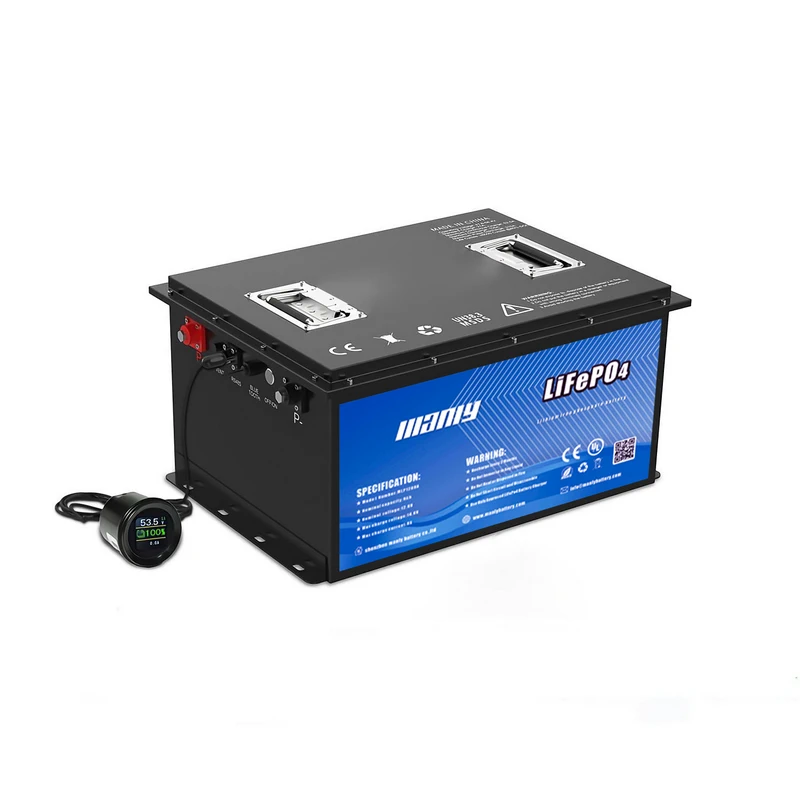2024 How to Handle Golf Cart Lithium Conversion with High-Speed Modules
Table of Contents
- 2024 How to Handle Golf Cart Lithium Conversion with High-Speed Modules
- Why Switch to Lithium Batteries for Your Golf Cart?
- When to Switch to Lithium Batteries for Golf Cart
- How to Choose the Right Golf Cart Lithium Battery
- Costs of Switching to Lithium Batteries for Golf Cart
- Best Practices for Maintaining Golf Cart Lithium Battery
- Getting Ready for Golf Cart Lithium Battery Conversion
- Step-by-Step Golf Cart Lithium Conversion Process
- Benefits of Golf Cart Lithium Battery Conversion
- The Role of High-Speed Modules in Golf Cart Lithium Conversions
- Key Problems in Golf Cart Lithium Conversions with High-Speed Modules
- Effective Solutions for Golf Cart Lithium Conversion with High-Speed Module Issues
- Conclusion
- Lithium Iron Phosphate Batteries: The Powerful Power Source for Electric Wheelchairs
- Samsung SDI is developing LFP batteries and new cylindrical batteries
- LiFePO4 battery is safe and reliable in UPS
Golf Cart Lithium Conversion with High-Speed Module Issues is a topic that raises concerns for many golf cart owners seeking to upgrade from traditional lead-acid batteries. While lithium batteries offer substantial advantages such as increased performance, longer range, and reduced maintenance, integrating them with high-speed modules can introduce challenges. In this article, we’ll explore the reasons for converting your golf cart to lithium, when to make the switch, how to choose the right battery, and how to address common issues that arise when combining golf cart lithium batteries with high-speed modules. By understanding these potential pitfalls and following best practices, you can ensure a successful conversion that enhances your golf cart’s overall performance and longevity.
Why Switch to Lithium Batteries for Your Golf Cart?
Converting your golf cart to use lithium battery for golf cart brings numerous benefits. Lithium batteries deliver superior performance and longer life compared to older models, making them a worthwhile investment. Here are some reasons to consider this upgrade:
- Improved Performance: Lithium batteries provide faster acceleration and better overall power delivery.
- Increased Range: With higher energy density, these batteries can power your cart for longer distances without needing frequent recharges.
- Less Maintenance: Unlike lead-acid batteries, lithium batteries require minimal upkeep, saving you time and effort.
When to Switch to Lithium Batteries for Golf Cart
Recognizing the right time to upgrade your golf cart batteries is essential. Here are key indicators that it might be time to make the switch:
- Damaged Batteries: Look for visible signs of damage, such as corrosion around the terminals or swelling of the battery case. These are clear indicators that your lead-acid batteries may be nearing the end of their life cycle.
- Diminishing Battery Capacity: If you notice your golf cart struggles to maintain speed or the range decreases significantly after a full charge, it may be time to consider lithium. A decline in performance often suggests that the existing batteries are failing.
- Excessive Maintenance: Lead-acid batteries require regular maintenance, including checking water levels and cleaning terminals. If you’re spending too much time on upkeep, switching to lithium could simplify your life.
- Desire for Better Performance: If you’re looking for enhanced performance, lithium batteries can offer improved speed and efficiency, making your golf cart feel like new again.
How to Choose the Right Golf Cart Lithium Battery
Selecting the appropriate golf cart lithium battery is crucial for ensuring compatibility and optimal performance.
- Matching Voltage Requirements: Make sure the voltage of the new golf cart lithium battery matches your golf cart’s requirements. Most golf carts operate on 36V or 48V systems. Ensure that the lithium battery for golf cart you choose aligns with these specifications.
- Properly Sized Batteries: Understanding the amp-hour (Ah) rating is essential for determining the right battery size. This rating indicates how much energy the battery can store and how long it will last.
- “Drop-In” Ready Battery Sizing: Opt for batteries that are designed to fit directly into your existing battery compartment without requiring modifications. This “drop-in” approach simplifies installation and minimizes complications.
- Preparing Your Golf Cart for Conversion: Before starting the conversion process, take the following steps to ensure a smooth transition:
- Evaluating Current Batteries: Assess the condition of your existing lead-acid batteries. Identifying issues early can save time and money during the conversion.
- Checking Compatibility: Verify that the new golf cart lithium batteries are compatible with your golf cart’s existing systems, including wiring and charging systems.
Costs of Switching to Lithium Batteries for Golf Cart
When considering a golf cart lithium conversion, it’s important to factor in the costs involved. While the initial investment may seem high, lithium batteries offer long-term savings in terms of reduced maintenance, longer lifespan, and increased efficiency.
Battery and Component Costs
The primary cost associated with the conversion is the price of the lithium batteries. Depending on the type and capacity of the battery you choose, prices can range from a few hundred dollars to several thousand dollars. For example, a high-quality lithium battery designed for golf carts might cost anywhere between $1,000 to $3,500.
Additional components such as battery management systems (BMS), wiring, and high-speed modules also add to the overall cost. However, it’s crucial to invest in quality components to ensure a reliable and efficient conversion.
Labor Costs
Labor costs can vary depending on whether you hire a professional to perform the conversion or choose to do it yourself. Hiring a technician with experience in how to convert golf cart to lithium could cost anywhere from $100 to $150 per hour. However, if you’re familiar with basic mechanical and electrical systems, you could potentially save on labor by completing the conversion on your own.
For those opting for professional installation, it’s essential to find a technician familiar with lithium systems to avoid complications and ensure proper integration with your golf cart’s existing components.
Long-Term Savings
Though the upfront cost of lithium battery for golf cart conversion may be higher than sticking with traditional lead-acid batteries, the long-term savings can outweigh this initial investment. Lithium batteries have a much longer lifespan—often lasting up to 10 years or more—compared to lead-acid batteries, which may need replacement every 3 to 5 years.
Lithium batteries also charge faster, reducing the downtime of your golf cart. Additionally, they require no maintenance, unlike lead-acid batteries, which require regular water checks and terminal cleaning.
Weight Savings
One of the often-overlooked benefits of switching to lithium batteries is the significant weight reduction. Lithium batteries weigh up to 50% less than their lead-acid counterparts. This weight savings can improve your golf cart’s speed, handling, and energy efficiency, further reducing long-term costs by consuming less power for the same performance.
Best Practices for Maintaining Golf Cart Lithium Battery
Proper care and maintenance are crucial for maximizing the lifespan and performance of your lithium batteries. While they require much less maintenance than lead-acid batteries, there are still important steps to follow.
Regular Charging
To get the best performance from your golf cart lithium batteries, make sure to charge them fully after each use. Lithium batteries are not subject to the memory effect that affects lead-acid batteries, so partial discharges will not negatively impact their lifespan. However, keeping the batteries fully charged helps maintain their capacity over time.
Store in a Cool, Dry Place
When not in use, it’s best to store golf cart lithium batteries in a cool and dry environment. Extreme temperatures—whether too hot or too cold—can impact battery performance and longevity. If you’re storing the golf cart for an extended period, it’s advisable to keep the batteries at about 50% charge and avoid exposing them to extreme conditions.
Monitor Battery Health
Using a battery management system (BMS) to monitor key indicators such as voltage, temperature, and charge levels is an essential practice for maintaining lithium battery health. A BMS can help prevent overcharging, over-discharging, and overheating, which are common issues that could shorten battery life.
Periodic Testing
Even though lithium batteries require less maintenance, it’s still a good idea to periodically test them. You can use a multimeter to check individual battery voltages or install a battery monitoring system that provides real-time data on performance.
Getting Ready for Golf Cart Lithium Battery Conversion
Proper preparation is essential to ensure a smooth and successful golf cart lithium conversion. By evaluating your current battery setup and verifying the compatibility of your golf cart components with lithium technology, you can prevent potential issues during the conversion process.
Evaluating Current Batteries
Before making the switch, it’s important to assess the condition of your current lead-acid batteries. This evaluation helps determine whether it’s the right time for a conversion.
You can start by checking for common signs of battery wear, such as corrosion on the terminals, swelling of the battery case, or acid leakage. If any of these issues are present, it’s a good indication that your batteries are nearing the end of their lifespan, making it the ideal time to replace them with lithium battery for golf cart systems.
Additionally, testing the battery’s performance with a full charge and discharge cycle can give you a better idea of how much capacity remains. If you notice a significant drop in driving range or power output, it’s time to upgrade to lithium batteries.
Checking Compatibility
Compatibility is a critical aspect of the conversion process. You need to ensure that the new lithium batteries will work seamlessly with your golf cart’s motor, wiring, and charging system.
First, verify the voltage requirements of your golf cart. Most carts operate on either 36V or 48V systems, so it’s essential to select a lithium battery that matches your cart’s voltage needs. Lithium batteries with incorrect voltage ratings could lead to inefficient performance or even damage to the cart’s components.
Additionally, ensure the wiring in your golf cart can handle the increased current flow from the lithium battery. You may need to upgrade to thicker wiring to accommodate the higher power output of the lithium battery for golf cart.
Lastly, check if your current charger is compatible with lithium batteries. Standard lead-acid chargers are not designed to properly charge lithium batteries and may damage them. Investing in a lithium-specific charger is crucial to ensure efficient and safe charging.
Step-by-Step Golf Cart Lithium Conversion Process
To ensure a smooth and successful golf cart lithium conversion, follow these steps:
Step 1: Remove the Old Batteries
Start by disconnecting the main cables from the lead-acid batteries. Always disconnect the negative cable first to avoid short circuits, then remove the positive cable. Once the cables are detached, carefully remove the old batteries from the tray. It’s a good idea to inspect the tray for any signs of rust or corrosion. Clean it thoroughly to ensure a stable base for the new lithium battery for golf cart.
Step 2: Install the Lithium Battery
Place the new lithium battery into the battery tray. Many lithium batteries are designed as “drop-in” replacements, meaning they fit directly into the existing battery space without the need for modifications. Ensure the battery is securely positioned in the tray before reconnecting any cables.
Step 3: Reconnect the Cables
Reconnect the cables, starting with the positive cable and then the negative cable. Make sure all connections are secure and free from corrosion to avoid any issues with power delivery or overheating. Double-check the cable connections to ensure they are attached to the correct terminals, preventing any potential damage.
Step 4: Connect the Main Power Cables
With the lithium battery in place, connect the main power cables. It’s helpful to take pictures of the original wiring setup before removing the old batteries, as this can guide you in properly reconnecting the new battery system. Ensure the polarity is correct when reconnecting the main cables.
Step 5: Set Up the Charging System
Lithium batteries require a charger specifically designed for lithium technology. Using a lead-acid charger could damage the battery. Choose a charger that matches the voltage of your lithium system (e.g., a 48V charger for a 48V system). These chargers typically shut off automatically when the battery reaches full charge, protecting the battery from overcharging. Set up the charger in a well-ventilated area, and follow the manufacturer’s installation guidelines.
Step 6: Install High-Speed Modules (Optional)
If you’re integrating a high-speed module, it can significantly improve your cart’s speed and responsiveness. High-speed modules are designed to optimize performance during and after the conversion, enhancing the overall driving experience of your golf cart.
Benefits of Golf Cart Lithium Battery Conversion
Converting your golf cart to lithium batteries offers numerous advantages that improve both performance and longevity. Below are some of the key benefits of making this switch:
Faster Charging Times
Lithium batteries charge significantly faster than lead-acid batteries. This means less downtime waiting for your cart to recharge and more time on the course or around the neighborhood.
Longer Lifespan
One of the most compelling reasons to switch to lithium is their extended lifespan. Lithium batteries can last up to 10 years, whereas lead-acid batteries may need replacing after 3-5 years. This longevity reduces replacement costs and increases the overall value of the golf cart lithium conversion.
Weight Reduction
Lithium batteries are much lighter than lead-acid batteries, which can weigh down your golf cart and negatively impact its speed and handling. The lighter weight of lithium reduces strain on the motor, allowing your golf cart to operate more efficiently and achieve higher speeds.
Consistent Power Output
Unlike lead-acid batteries, which lose power as they discharge, lithium batteries provide consistent power output throughout their charge cycle. This means your golf cart will maintain the same level of performance, whether the battery is fully charged or nearing empty.
The Role of High-Speed Modules in Golf Cart Lithium Conversions
When upgrading your golf cart to lithium battery for golf cart, one of the most exciting possibilities is increasing the cart’s speed with the use of high-speed modules. These modules modify the electronic speed controller (ESC) to allow for faster acceleration and higher top speeds. However, integrating high-speed modules with a lithium conversion can sometimes present challenges, including compatibility issues with the motor controller, voltage irregularities, and potential damage to other components if not properly managed.
What Do High-Speed Modules Do?
High-speed modules adjust the electronic speed controller to increase the speed output of your golf cart. While stock carts are often limited to lower speeds for safety reasons, installing a high-speed module can bypass these limits, allowing you to take full advantage of the improved power output from the lithium battery.
However, with the increased power that lithium batteries provide, it’s important to ensure that the module is properly calibrated to avoid issues such as motor overheating, erratic throttle response, or even failure of electrical components.
Key Problems in Golf Cart Lithium Conversions with High-Speed Modules
Voltage Compatibility Problems
One of the primary issues that arise during a golf cart lithium conversion with high-speed modules is voltage compatibility. Lithium batteries generally operate at a higher and more consistent voltage than lead-acid batteries, which can cause problems with components that were designed for the lower and more variable voltage of lead-acid systems.
Solution:
Before installing the high-speed module, verify that your motor controller and high-speed module are compatible with the higher voltage provided by the lithium battery. Upgrading the motor controller or using a module specifically designed for lithium systems can help avoid voltage mismatches that could lead to performance degradation or equipment damage.
Battery Management System (BMS) Conflicts
The battery management system (BMS) is a critical component of lithium battery setups, designed to protect the battery by regulating charging, discharging, and preventing overcurrent or short circuits. However, integrating a high-speed module with a BMS can sometimes result in conflicts where the BMS limits the current supply to the high-speed module, reducing performance.
Solution:
Ensure that the BMS is capable of handling the current demands of both the lithium battery and the high-speed module. If necessary, upgrade the BMS or recalibrate the module to ensure smooth power delivery without overloading the system.
Motor Overheating
Lithium batteries deliver a much higher and more consistent current than lead-acid batteries, which can strain a motor not built to handle the increased power, especially when paired with a high-speed module. This can lead to overheating, which not only decreases performance but also risks damaging the motor over time.
Solution:
Consider upgrading the motor to one rated for higher speeds and power output. Additionally, you can install cooling systems like heat sinks or fans to help dissipate excess heat, preventing the motor from overheating during extended periods of high-speed operation.
Wiring and Connection Issues
Higher current from the lithium battery can expose weaknesses in your existing wiring setup, leading to potential problems like overheating, voltage drops, or even electrical fires.
Solution:
Upgrade your wiring to thicker gauge cables capable of handling the increased current flow. This will ensure a more efficient and safer power transfer from the battery to the high-speed module and motor.
Throttle Response Issues
When switching from lead-acid to lithium, you might notice that the throttle response becomes either too sensitive or too sluggish. This difference in power delivery between battery types can make it challenging to control the golf cart, particularly at higher speeds.
Solution:
Recalibrate the throttle controller to match the new power output from the lithium battery. Adjusting the acceleration curve on the controller can help provide smoother and more predictable throttle response, making the cart easier to control even at higher speeds.
Regenerative Braking Conflicts
Regenerative braking is a feature in some golf carts that uses the motor to generate power while slowing down the cart, feeding that power back into the battery. However, when converting to lithium, the regenerative braking system may not work correctly due to differences in how the lithium battery’s BMS handles the incoming power.
Solution:
Consult the manufacturer or an expert to either adjust the regenerative braking system to work with the lithium battery or disable it altogether if it causes issues. In some cases, the braking system can be recalibrated to work with the new battery setup, ensuring smoother and more efficient operation.
Effective Solutions for Golf Cart Lithium Conversion with High-Speed Module Issues
To ensure a successful golf cart lithium conversion, particularly when integrating high-speed modules, follow these best practices:
Choose Compatible Components
Ensure that every component you select, including the lithium battery, high-speed module, and motor controller, is designed to work together. Incompatible components can lead to inefficient power usage or system failures.
Upgrade the Speed Controller
Many stock speed controllers are not designed to handle the increased power output of lithium batteries, especially when combined with high-speed modules. Consider upgrading to a programmable speed controller that can be adjusted to optimize the performance of your new setup.
Monitor Battery Health
A BMS is essential to ensure that your lithium battery stays healthy over time. It monitors key factors such as voltage, temperature, and power output. Regularly checking the status of your battery can help prevent issues such as overcharging or overheating, which could shorten its lifespan.
Test in Phases
After installing the high-speed module and lithium battery, it’s important to test your golf cart in phases. Begin by testing at lower speeds and gradually increase to higher speeds. This methodical approach will help you identify any potential issues early and allow you to make adjustments before pushing the system to its limits.
Conclusion
Converting your golf cart to lithium batteries, especially with the addition of high-speed modules, can greatly improve performance, speed, and efficiency. However, there are several technical challenges you may face, such as voltage compatibility issues, BMS conflicts, motor overheating, and wiring problems. By following the outlined solutions and best practices, you can ensure that your golf cart lithium conversion is smooth, safe, and delivers long-term benefits.






